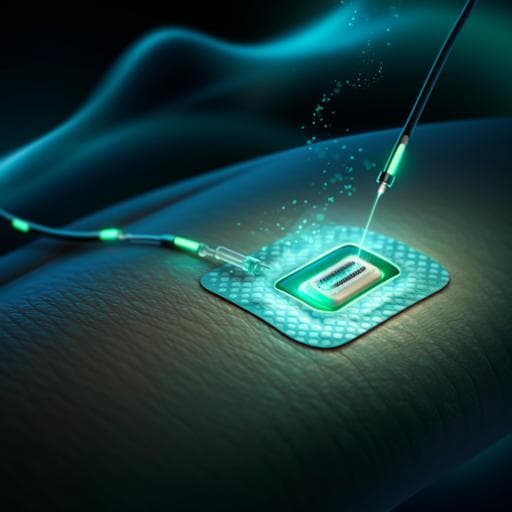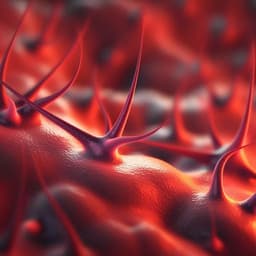
Medicine and Health
Programmable CRISPR-Cas9 microneedle patch for long-term capture and real-time monitoring of universal cell-free DNA
B. Yang, J. Kong, et al.
Discover cutting-edge research by Bin Yang, Jilie Kong, and Xueen Fang on a groundbreaking wearable microneedle patch that enables long-term monitoring of universal cell-free DNA (cfDNA). This innovative approach harnesses CRISPR technology and reverse iontophoresis for efficient extraction and has shown promising results in monitoring vital health conditions.
~3 min • Beginner • English
Introduction
Wearable technologies are poised to transform personalized medicine by enabling continuous, minimally invasive monitoring. While most existing wearables target small molecules and electrolytes in sweat or other biofluids, there is a pressing need for platforms that can effectively extract and continuously monitor macromolecular biomarkers such as proteins and nucleic acids. Interstitial fluid is compositionally related to blood and is accessible using microneedles, but integrating efficient extraction with real-time sensing for nucleic acids remains challenging. The authors aim to address this gap by creating an online, minimally invasive wearable system that both enriches and continuously detects cell-free DNA (cfDNA) directly in vivo without nucleic acid amplification. Their central hypothesis is that combining programmable CRISPR-Cas9 binding with high-mobility graphene biointerfaces and microneedle-enabled reverse iontophoresis will enable specific, real-time cfDNA monitoring from ISF with high sensitivity and stability.
Literature Review
Prior work on wearables largely focused on small-molecule analytes using soft materials, flexible electronics, and electrochemical sensors. Microneedles have been used to extract interstitial fluid and, in earlier studies by the same group, hydrogel microneedle patches enabled DNA capture followed by offline analysis. However, offline methods require frequent operations and lack real-time feedback. CRISPR technologies, guided by sgRNA/CrRNA and Cas effectors, have enabled sequence-specific nucleic acid detection (e.g., HUDSON-SHERLOCK and DETECTR). Amplification-free CRISPR approaches have emerged: graphene FETs functionalized with Cas9 achieved femtomolar detection of unamplified genes; Cas13a platforms detected SARS-CoV-2 at 100 copies/µL. Despite promise, most amplification-free strategies operate at pM–fM sensitivity and are not integrated into wearable formats for continuous in vivo monitoring. This work builds on these advances by integrating CRISPR recognition with graphene-based microneedle sensors and reverse iontophoresis for real-time cfDNA tracking.
Methodology
Device architecture and principle: The wearable patch consists of (1) a flexible PDMS substrate modified to be hydrophilic via plasma treatment and a chitosan coating; (2) a spray-printed carbon nanotube (CNT) pattern forming an anode–cathode compartment for reverse iontophoresis-driven enrichment of negatively charged cfDNA; and (3) a three-electrode conductive microneedle (MN) array serving as the working (CRISPR-functionalized), reference (Ag/AgCl), and counter (carbon) electrodes. Carboxylated graphene nanoflakes are deposited on MNs to create a high-mobility biointerface. Catalytically inactive Cas9 (dCas9) is covalently immobilized on graphene via EDC/NHS chemistry and PBA linkers (for microelectrodes) and then programmed with target-specific sgRNA (forming dRNP). Target binding at the graphene interface alters interfacial ion distributions, generating a Donnan potential and measurable changes in current (i–t), enabling real-time readout.
Microneedle fabrication: Hydrogel MNs (PMVE/MA with PEG) are replicated using a metallic mold through PDMS and Ecoflex masters. For conductivity, MNs are plasma-treated, coated with Cr dispersion in chitosan, sputtered with Au, wired with Au leads, and insulated with Ecoflex. Reference MNs are coated with Ag/AgCl ink; counter MNs with carbon paste. Morphology and thickness are verified via stylus profilometry, SEM, and AFM; mechanical strength is characterized by compression tests (1 kN sensor).
Surface functionalization: For microelectrode validation, graphene/chitosan is drop-cast, PBA is π–π stacked, and EDC/NHS activation enables dCas9 coupling; BSA blocks non-specific sites; sgRNA is incubated to form the active dRNP layer. For MNs, carboxyl graphene is drop-cast and EDC/NHS activation couples dCas9; BSA blocking and sgRNA loading complete the CRISPR MN.
Wearable patch construction: A PDMS film (plasma-treated, chitosan-coated) is spray-printed with CNTs through a mask to create the reverse iontophoresis module. The three-electrode MN array is attached to the anode side with adhesive. A flexible paper battery supplies 10 V for iontophoresis during operation.
Electrochemical characterization: CV, DPV, EIS, and i–t measurements are conducted in standard redox probes and PBS to validate conductivity, diffusion-limited behavior, and real-time recording capability. Contact angle measurements confirm increased wettability of modified PDMS. Finite element analysis evaluates mechanical deformation tolerance (stretching, twisting, bending). Mechanical tests determine strain–stress behavior, gauge factor, endurance cycles, and the integrity of CNT percolation networks under deformation.
In vitro tests: A three-layer PDMS skin microfluidic chip (epidermis/dermis/endothelium equivalents with HaCaT, HUVEC, and HFF cells) simulates skin. Reverse iontophoresis (10 V) enriches cfDNA to the MNs for real-time monitoring. EBV BamHI-W region cfDNA, sepsis-associated cfDNA, and kidney transplantation-associated cfDNA (SRY) targets are tested at varying concentrations with interference from fetal bovine serum. Real-time Iresponse is calculated as (It−I0)/I0×100%. Time thresholds and slopes (dI/dt) are used for kinetics and quantitation; calibration curves are built over 30–30,000 fM. Anti-interference is assessed at 0%, 10%, and 60% FBS. Long-term stability is evaluated by storing MNs in 2% agarose gel or laminated in vivo and then testing daily.
In vivo tests: BALB/c nude mice are implanted subcutaneously with luciferase-tagged CNE cells (CNE-Luc) to generate EBV cfDNA. The wearable operates in intermittent cycles to avoid signal crossover: 3 min calibration, 3 min reverse iontophoresis (10 V) for extraction, then 3 min biosensing readout; cycles repeat for real-time tracking at multiple time points (2, 8, 24, 48, 72, 120 h and up to 5 days). Parallel bioluminescence imaging and gold-standard PCR from blood are used for cross-validation. MN penetration depth is confirmed via HE histology on piglet skin.
Specificity and affinity: CRISPR specificity is verified against non-target viral sequences (WENV, JPEV, DENV). UV–vis spectroscopy quantifies dRNP–target binding constant. PAGE and next-generation sequencing confirm CRISPR editing/target binding in solution. Statistical analyses use two-way ANOVA and linear regression.
Key Findings
- The CRISPR-activated graphene MN wearable enables amplification-free, real-time monitoring of cfDNA directly from interstitial fluid.
- Sensitivity and quantitation: Linear dynamic range from 30 to 30,000 fM (log-scale fits) for EBV cfDNA. Microelectrode validation yielded LOD ~1.1 fM (LOD = 38/K); CRISPR MNs achieved LOD ~1.2 fM (38/K) with sensitivity down to 3 × 10^-14 M in the presence of interferents. Time threshold for reaction onset around ~12 min; slopes (dI/dt) scale with concentration.
- Specificity: No significant response to non-target viral sequences (West Nile, Japanese encephalitis, dengue) compared with EBV cfDNA at 1 × 10^-10 M.
- Anti-interference: With 3 × 10^-12 M EBV cfDNA, 10% FBS yielded RSD 2.49% relative to 0% FBS; 60% FBS increased variability (RSD 20.95%) yet preserved the characteristic S-shaped response within 75 min.
- Long-term stability: In vitro stable sensitivity over 12 days (C.V. 3.71% for minimal detection concentration). In vivo stable signal and time thresholds over 8 days (C.V. 4.81%), with effective operation up to 10 days.
- In vivo performance: In CNE-Luc-bearing mice, real-time Iresponse tracked EBV cfDNA dynamics (peak at 24 h; Iresponse ~256%), closely paralleling bioluminescence signals. Significant differences from controls persisted at 120 h. Qualitative detection in mice matched gold-standard PCR.
- Universality: The platform monitored sepsis-associated cfDNA and kidney transplantation-associated cfDNA (SRY) on the skin chip with concentration-dependent responses and significant signal over controls.
- Microneedle mechanics and penetration: MNs penetrated piglet skin to 332–426.9 µm (epidermis ~27 µm thick). Under up to 6% loading, each needle stress exceeded 43.1 kPa without collapse. The wearable exhibited maximum elongation at break of 26.8%, gauge factor ~282.6, and maintained conductive pathways under stretching, twisting, and bending.
- Interface affinity: UV–vis estimated dRNP–EBV cfDNA binding constant K ≈ 1.02 × 10^7 L/mol, supporting strong target binding at the interface.
- Materials and electronics: Modified PDMS with chitosan improved wettability (WCA reduced from ~98° to ~35°); CNT percolation networks remained conductive under mechanical distortions; MNs produced ~6.5× higher real-time current signals than a commercial Au electrode in PBS.
Discussion
The study demonstrates that combining programmable dCas9/sgRNA with graphene microneedle biointerfaces and reverse iontophoresis overcomes a key barrier in wearable biosensing: integrating efficient extraction with continuous, sequence-specific detection of nucleic acids in vivo. The dRNP provides ongoing target interrogation with high specificity, while the graphene interface transduces binding events into robust electrochemical signals via interfacial ion redistribution (Donnan potential), enabling real-time readouts without amplification or bulky instrumentation. The platform captured clinically relevant cfDNAs (EBV, sepsis-related, and transplant-derived) with femtomolar sensitivity, maintained performance in complex matrices (up to 60% serum), and showed stable operation for up to 10 days in vivo, addressing the need for longitudinal monitoring in settings such as ICU care and transplant surveillance. In mice, cfDNA dynamics tracked tumor progression and correlated with bioluminescent imaging, suggesting utility for early disease screening when imaging may be insensitive. While the quantitative capacity matched calibration in vitro, in vivo use currently supports robust qualitative and semi-quantitative assessments. Overall, the findings advance wearable nucleic acid sensing toward practical, continuous monitoring of disease-related cfDNA.
Conclusion
This work introduces a fully integrated, amplification-free, CRISPR-Cas9-activated graphene microneedle wearable that performs on-demand extraction and real-time monitoring of cfDNA from interstitial fluid. The device achieves femtomolar LODs, strong specificity, anti-interference in serum-rich environments, and sustained sensitivity for up to 10 days in vivo. It enables longitudinal tracking of EBV cfDNA in mouse tumor models and demonstrates versatility by detecting sepsis- and transplant-associated cfDNAs. The platform’s programmability via sgRNA suggests broad applicability across genomic targets. Future directions include improving receptor immobilization stability, enhancing sensitivity toward single-copy levels (e.g., via multiple Cas proteins, ordered mesoporous nanomaterials, metallic MNs, and pre-calibration strategies), and validating sepsis and transplant use cases in animal and clinical studies to elucidate ISF nucleic acid dynamics and disease progression relationships.
Limitations
- Sensitivity constraints: As an amplification-free approach, current sensitivity, though femtomolar, may be insufficient for ultra-low abundance targets (single-copy per µL) compared to amplified assays.
- Bioreceptor stability and interface effects: Immobilized bioreceptors may experience activity fluctuations under continuous mechanical deformation and harsh environmental exposure typical for wearables, potentially impacting accuracy.
- Quantitation in vivo: While qualitative accuracy matched PCR, fully quantitative in vivo calibration remains to be established due to factors like diffusion-limited transport, variable time thresholds, and complex tissue environments.
- Long-term biofouling and matrix effects: Despite demonstrated stability up to 10 days, longer-term biofouling or variable ISF composition could affect performance and require protective layers (e.g., hydrogels/chitosan) or regeneration strategies.
Related Publications
Explore these studies to deepen your understanding of the subject.







